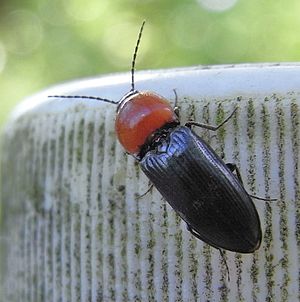Cardiophorus gramineus
| Cardiophorus gramineus | ||||||||||
|---|---|---|---|---|---|---|---|---|---|---|

Cardiophorus gramineus |
||||||||||
| Systematics | ||||||||||
|
||||||||||
| Scientific name | ||||||||||
| Cardiophorus gramineus | ||||||||||
| ( Scopoli , 1763) |
Cardiophorus gramineus is a beetle from the family of beetles . The scientific genus name Cardiophorus is from Altgr. καρδία kardīa "heart" and φόρος phóros "carrying" derived and refers to the heart-shaped label (Fig. 1). The species name gramineus ( Latin ) means “living on grass”. The genus Cardiophorus is represented in Europe by two subgenus, the subgenus Cardiophorus alonecomprises around sixty species in Europe.
Characteristics of the beetle
The beetle can be identified with relative certainty by its color. The pronotum is completely red, at most the edge of the base and sometimes the front edge are blackened, the rest of the body is deep black. The body length is eight to almost ten millimeters. The upper side is covered with fine hairs (Fig. 2).
The mouthparts point downwards. The forehead is lined, rises above the head shield like a roof and is much higher than the upper lip . The eleven-part antennae are turned in to the side under the protruding forehead. They are at most weakly sawn inwards.
The pronotum is strongly arched and very finely dotted . A short keel rises from the outer corners of the base of the pronotum (rear angle) (Fig. 2, bottom right, red), which laterally delimits the top of the pronotum and thereby simulates a side edge of the pronotum. Viewed from the side, however, you can see that the very finely developed lateral edge of the pronotum begins at the rear under the keel, turns to the underside of the pronotum and disappears before it reaches the anterior edge of the pronotum. The front chest is enlarged on the underside forwards and backwards. The rounded extension to the front protects the mouthparts when the beetle withdraws its head. The fore-chest process towards the back, which can be inserted into a recess in the mid-chest as part of the rapid apparatus, is truncated and appears chopped off in a side view (hidden in Fig. 2). There are no channels for inserting the sensors.
The upper wings are curved and striped in cross section. The large label in the striking heart shape (Fig. 1) can only be found in three species in Central Europe.
The legs have five-limbed narrow tarsi . The claws are imperforate.
biology
The species is found in wooded areas in a warm location, especially in oak forests. The larvae live predatory in sandy or loamy soils at the foot of old trees, which are often inhabited by the brown garden ant ( Lasius brunneus ). Occasionally they are also found in trees in muddy areas, for example on the floor of tree hollows or in the drill holes of other wood insects. Development takes at least two years. In August, the larva builds a pupal chamber in the ground 20 to 30 cm deep or in tree dust. The hatched beetles hibernate in the pupa chambers. The adults can be found from May to July on lower plants and shrubs near the trees in the breeding area.
distribution
The species is distributed in southern and central Europe, to the north the range extends to Belgium , the Netherlands , southern Sweden , Poland , Ukraine , central and eastern Russia . In Germany the species is rare in the south and very rare in the north. In the south it is only missing on the Mediterranean islands. The species is also reported from the Caucasus .
literature
- Heinz Joy, Karl Wilhelm Harde, Gustav Adolf Lohse: The beetles of Central Europe . tape 6 : Diversicornia . Spectrum, Heidelberg 1979, ISBN 3-87263-027-X .
- Gustav Jäger (Ed.): CG Calwer’s Käferbuch . K. Thienemanns, Stuttgart 1876, 3rd edition
- Edm.Reitter: Fauna Germanica, the beetles of the German Empire III. Volume, KGLutz 'publishing house, Stuttgart 1911
Individual evidence
- ↑ a b Cardiophorus gramineus in Fauna Europaea. Retrieved February 2, 2011
- ↑ Sigmund Schenkling: "Explanation of the scientific beetle names"
- ↑ Cardiophorus (subgenus) in Fauna Europaea. Retrieved February 2, 2011
- ↑ a b Polish coleopterological website

